It is extremely unlikely you’ll use less water and energy by washing dishes by hand, compared to using a dishwasher. That’s what Jonah Schein of the US Environmental Protection Agency (EPA) said to the Washington Post about Energy Star-certified dishwashers.
Finally! A reason to stop feeling guilty about letting the dishwasher do the dirty work for us. Dishwashers save us nearly 10 days per year compared to washing dishes by hand. They’re our best friends in the kitchen!
But if the dishes come out dirty from your dishwasher, you’re not saving as much time.
Your dishwasher may not be at fault. It is possible to improve the quality of the cleaning by changing the way you load your dishwasher. Today we’ll show you the best way to load a dishwasher properly.
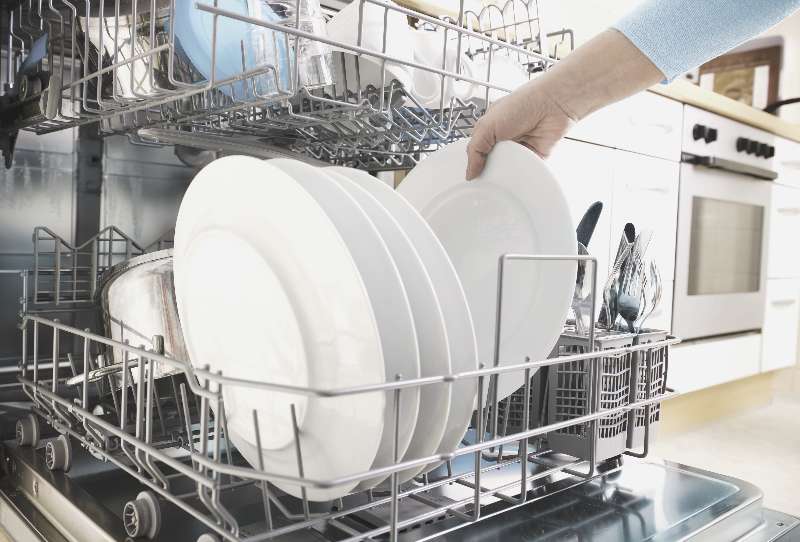
But First, What Goes in a Dishwasher?
Not every item is safe to use in the dishwasher. Putting things in it that are not dishwasher-safe can lead to your favorite plastic bottle to melt and deform. Or your best pan to become brittle and sticky.
Plastics
Containers made of dishwasher-safe plastics are generally safe to use. They can withstand the heat generated by your dishwasher without melting or releasing chemical agents like BPA that would contaminate the rest of your load.
Look for the dishwasher-safe indication on your plastic containers to know whether you can put them in the dishwasher.
Pots and Pans
Pots and pans that are rated dishwasher-safe are great! If loaded correctly, stainless steel pots generally come out clean and without any damage over time.
Dishes
Dishes are the most common items placed in the dishwasher. As long as the plates don’t touch each other, they will come out clean and unchipped.
Glasses
Standard drinking glasses and wine glasses can all go in the top shelf of the dishwasher. Make sure they are not touching each other to prevent accidental cracks and chipping during the cycle.
Your best set of crystal glassware, however? It would be better if you washed them by hand. The heat generated by the dishwasher and the chemicals present in the detergent can both dull and scratch the surface.
Utensils
You can safely wash silverware in the dishwasher, as long as it’s not made of sterling silver. Make sure they’re made of stainless steel or another dishwasher-safe alloy.
And What to Absolutely Avoid Putting in the Dishwasher?
The following items can get damaged over time if you place them in the dishwasher. It is best to handwash:
Large Kitchen Knives
You should never put in the dishwasher the sharp knives that you use to cut vegetables, chop meats, and mince herbs in the kitchen. The intense heat and the chemicals used in the detergent will attack the blade and make them dull.
Silver, Iron, Bronze, Brass, Copper Items
Any item made from those metal will deteriorate quickly in the dishwasher. Silver will tarnish. Iron will rust a little more with each cycle. Bronze will change color, and brass and copper will corrode as well.
Wood
Wood doesn’t play well with heat and water! Wooden utensils, bowls, and cutting boards left in the dishwasher will quickly bloat, deform and eventually crack. You’re better off washing those by hand.
Ceramic-Coated Cookware
Ceramic-coated cookware can be put in the dishwasher occasionally. But over time, the detergent will take a toll on the finish, and it could become rough and more sticky. If you care about this cookware, you should clean it by hand.
Plastics Containing BPA
Plastics that are NOT dishwasher-safe are dangerous to use in the dishwasher.
The intense heat present during some washing cycles can cause chemicals like BPA to leach out of the plastic. These chemicals can disrupt the hormonal balance in the body. Some have even been associated with heart disease, type 2 diabetes, and cancer.
These types of plastics should not only be avoided with dishwashers, but also with microwaves, and with food in general.
Should You Rinse Dishes Beforehand?
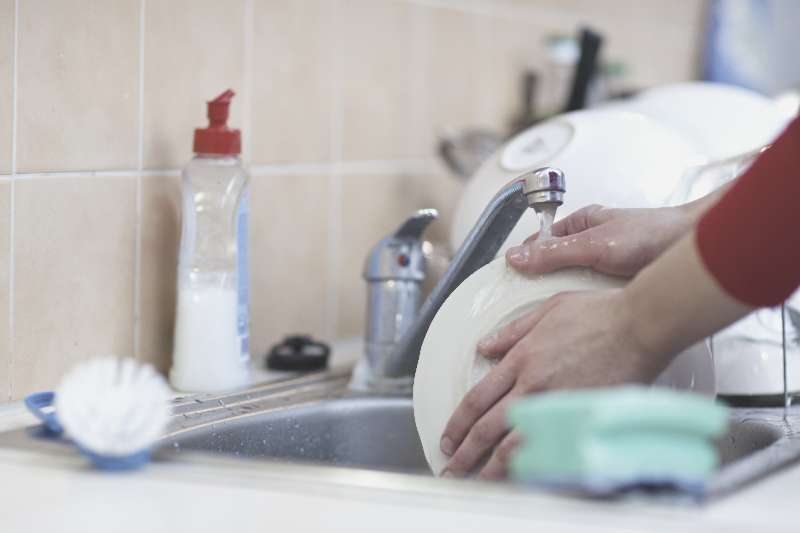
I used to scrub my dishes thoroughly under warm water before putting them in the dishwasher. I like my plates clean, you know? Until I realized that I was doing the job twice. I was doing most of the dishwasher’s work and wasting time doing so. I was wasting water, energy, and not being eco-friendly.
Instead, I learned how to load my dishwasher optimally and use the right detergent. I’m now getting the same results I was before, with less work and with a smaller ecological footprint.
You don’t have to rinse or scrub the dishes before putting them in the dishwasher. However, do the following:
- Scrape off any big chunks of food – You don’t want this food getting stuck in the drain of your dishwasher. Removing leftover food from the dishes will also prevent the food from flying around inside the dishwasher during its cycles. The food could land on a clean plate and dry off there, making it very hard to remove.
- Test the limits of your dishwasher – Each dishwasher is unique. Newer dishwashers generally do a better job at cleaning, and you can get away with dishes that are a lot dirtier. Knowing the limits of what your dishwasher can do will help you minimize the time you spend rinsing the dishes beforehand.
What Detergent is Best to Use in a Dishwasher?
The best detergent for dishwashers has been evolving over the years. It was prevalent to use powder soap a few years ago. But the soaps that give the best results nowadays are all in the form of detergent packs.
In fact, “The best-performing detergent packs clean better than the best gels,” according to Joe Pacella from the Consumer Reports. It is mostly because those packs contain a variety of detergents within them. Some include pre-wash, a degreaser, bleach, and rinse aid, all of which are activated automatically during the washing cycle. It is hard to beat those packs with a pure powder or gel detergent.
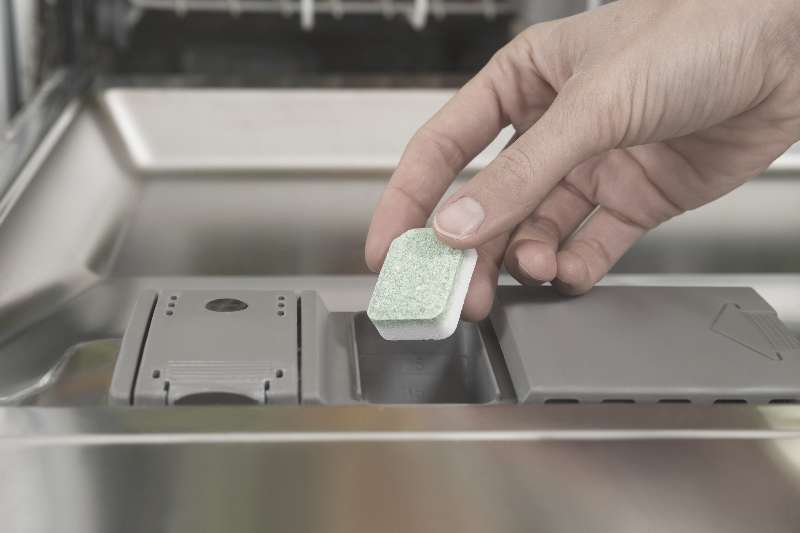
Thus, I would recommend you research the best detergent packs you can buy in your area. Here are a few recommendations from the Consumer Reports to get you started:
- Cascade Platinum ActionPacs with the Power of Clorox
- Kirkland Signature Premium Dishwasher Pacs
- Member’s Mark Ultimate Clean Dishwasher Pacs
Despite using the best detergent you can find, it is possible that your dishwasher still doesn’t meet your expectations. If that’s the case, your water might be too cold to clean the dishes effectively.
Optimal Water Temperature for Your Dishwasher
While many detergents nowadays are effective in cold water, there’s nothing that can beat the dissolving power of hot water. You should aim to have a water temperature of 120F (49C) for maximum efficiency.
It is straightforward to test the temperature of your water at home: simply run the water in your sink until it’s hot and fill a large glass of water. You can then measure the temperature of the water with a cooking thermometer.
If you find that your water is below 120F, see if you can adjust your water heater to reach the right temperature. But you need to be very careful! If the temperature of the water goes above 140F, you significantly increase the risks of getting severe burns when washing your hands or taking a shower. Try not to go above 140F.
Here’s a short video demonstrating how to take the water temperature measurement for a home:
Loading the Top Rack
Use the top rack of the dishwasher to place smaller and more fragile items. The jets that reach the top of the dishwasher are gentler than those coming from the bottom. It is thus the ideal location to put all glassware, cups, small bowls, and dishwasher-safe plastic items.
Glasses and Cups
Place glasses and cup on the top rack. You want to ensure they don’t touch each other to prevent cracks and chips during the washing cycles.
Try to angle the glasses a little bit so that the interior faces toward the center of the dishwasher. Doing so will help in two ways:
- First, it will allow the jets to reach the interior of the glassware and ensure proper cleaning.
- Second, it will help prevent the accumulation of water on the top of the glasses and cups and help dry them completely.
Wine Glasses
Wine glasses are typically more fragile than regular glassware.
If you decide to wash them in the dishwasher, make sure to use the glass support rack if your dishwasher has one. It will help separate the wine glasses properly and hold them in place during the cycles.
If your dishwasher doesn’t have a support rack for wine glasses, you can buy flexible silicone holders that attach the glass to a dishwasher post. It will maintain the glass in place and prevent it from moving.
Dishwasher-Safe Plastic Items
If your plastic containers are dishwasher-safe (always check!), you can put them in the top rack.
You need to avoid putting them in the bottom rack because the heating element at the bottom of the dishwasher may melt and deform the plastic. Even if your dishwasher doesn’t have a visible heating element, the strong jets from the lower arms may dislodge the containers. They can start moving around in the dishwasher, preventing them (and other items) from getting a complete wash.
You may find that plastic items don’t dry as well in the dishwasher as your other items. If you can’t angle them to prevent the accumulation of water, you’ll need to dry them off with a towel before stowing them away in your kitchen cabinets.
Small Bowls, Saucers and Other Small Items
The top rack is the perfect place to wash smaller items that could fall through the larger meshing of the bottom shelf. You just need to make sure that more delicate pieces don’t touch each other in the dishwasher to prevent chipping.
Long Pieces of Cutlery
You should also place larger pieces of cutlery on the top rack. Avoid putting them in the silverware basket. They would block water and prevent the smaller pieces of cutlery from getting a thorough wash.
Simply lay down spatulas made of plastic or metal on the top rack. You want large serving spoons facing down to prevent water from accumulating in them.
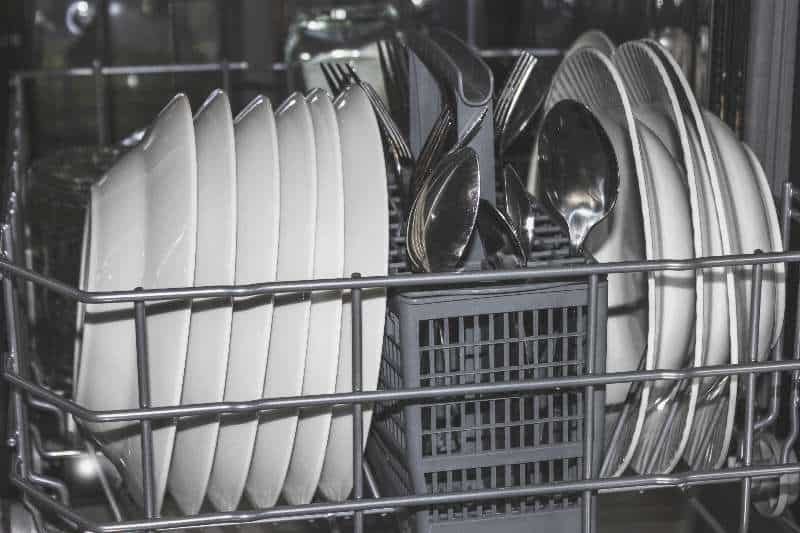
Loading the Bottom Rack
The bottom rack is where the heavy-duty action takes place. It is where you will place plates and larger items like bowls, bakeware, pots and pans, and cutting boards.
The jets coming from the bottom of the dishwasher are the strongest. You must not put fragile items there, as they can break more easily. It is especially true if they’re light, and they start flying around in the dishwasher!
Remember that the jets are mostly coming from the center of the dishwasher and go outward. If you want to make sure each item gets a good scrub from those jets, put their dirtiest face toward the center of the dishwasher whenever possible.
Here’s what you should put on the bottom rack of your dishwasher for optimal results:
Plates
Lay the plates between the posts of the bottom shelf. Make sure that the water can flow freely between the dishes, and that they don’t touch other objects to prevent chipping.
Some dishwashers will separate the bottom rack in two sections, both of which will face the center of the dishwasher. This design is to ensure the dirty side of the plates face the center of the dishwasher and will get you better results.
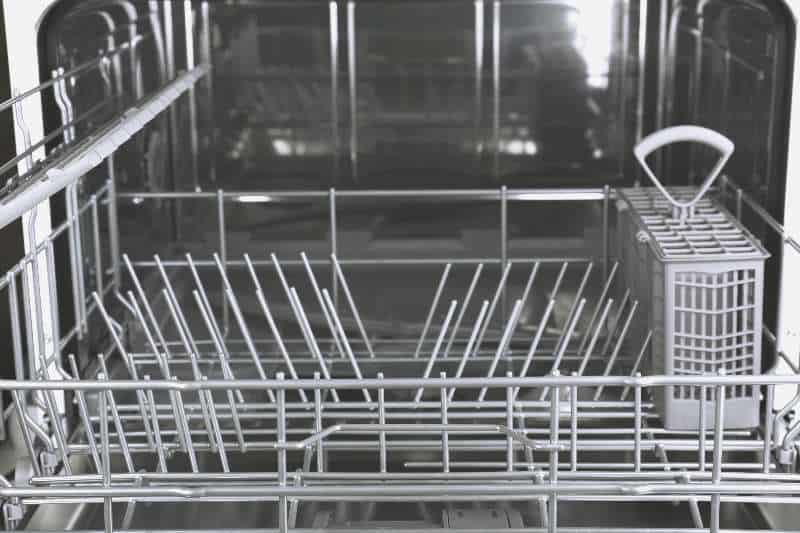
Large Bowls
You should place large bowls with the inner side down and toward the center of the dishwasher. This orientation will allow the jets from the bottom spray arm to reach the inside.
Cutting Boards and Platters
If you have a cutting board made of glass or a dishwasher-safe plastic, you can place it on the side, front, or back of the bottom rack. Doing so will not hinder the flow of the water within the dishwasher.
You need to make sure you’re not blocking the upper spray arm by giving it a gentle spin to see if it rotates freely. Also, avoid blocking the door of the soap dispenser with such large items.
You can place large platters in the same way.
Pots and Pans
If your cookware is made of a dishwasher-safe material like stainless steel, you can put it on the bottom rack, face down toward the spray arm.
However, you need to be careful with nonstick pans. Even if they are rated dishwasher-safe, putting them in the dishwasher will damage the surface over time, and they may end up sticking a lot more.
They can also become more fragile after a few years in the dishwasher. I try to wash those by hand, despite the indications that mention them being safe to use in the dishwasher.
You also need to avoid putting pots and pans made of aluminum if the dishwasher, according to The Spruce. The detergents can corrode, dull, or darken them if they haven’t been anodized (a process used during manufacturing to make the aluminum strong). You’re better off washing those by hand.
Bakeware
You can also put bakeware in the dishwasher. The bottom rack is where you want your muffin pans, cake molds, and cookie sheets to go. Place them face down toward the spray arm in the dishwasher.
But some stains can be tough to remove. You may have to scrub bakeware thoroughly by hand before putting them in the dishwasher.
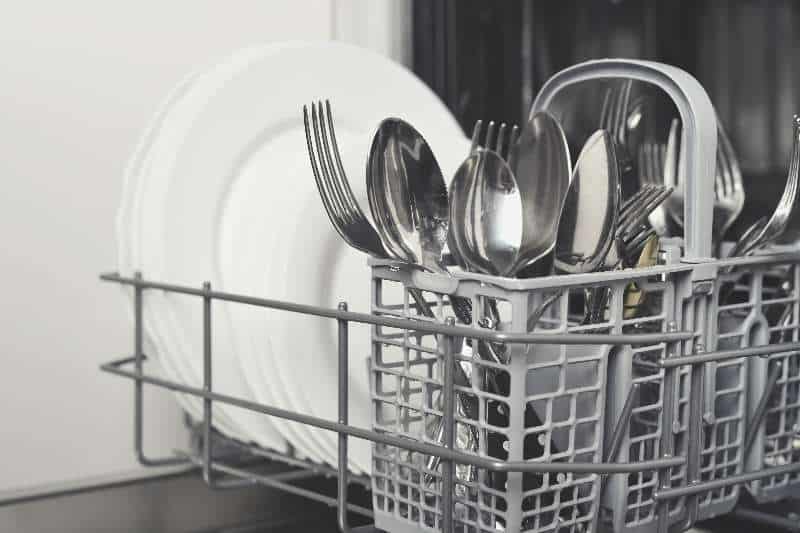
Silverware
Every dishwasher comes with some variation of a silverware basket used to hold utensils in place during the washing cycles. My girlfriend and I spent many long evenings debating over the best way to put silverware in those baskets (just kidding – the discussion lasted two minutes, as she forced me to yield quickly).
She was mixing knives, forks, and spoons within the same compartments. It was very annoying to me, as I found it a bit more tedious to unload the silverware from the basket once it was clean. But in the end, I had to concede: she was right. Here’s the best way to load silverware in the dishwasher:
- Place forks and spoons in the silverware basket with the handle down. Doing so will give the dirtiest part of the utensils more exposure to water. They will come out cleaner.
- Place knives with the blade down and the handle up. While this may give a knife a less thorough cleaning, it will lessen the risk of injury as the pointy end will be hidden safely in the silverware basket.
- Mix knives, forks, and spoons within the same compartments. One thing that you must prevent to ensure clean utensils is nesting. By mixing different types of utensils, you help stop the forks and spoons from nesting together.
You should not place larger utensils, like large serving spoons and spatulas, in the silverware basket. Doing so would prevent the flow of the water from the jets from reaching the other utensils. Instead, you should lay down those items in the top rack.
10 Bonus Tips to Maximize the Efficiency of Your Dishwasher
In addition to making sure you load your dishwasher correctly, you can use the following tips to help your dishes come out clean every time:
- Run the kitchen sink until the water is hot before starting the dishwasher. Doing so will prevent the dishwasher from starting its cycle with cold water.
- Unload the bottom rack first. If you start with the top shelf, some items may drip water over the dishes on the bottom rack. It is especially true for plastic containers, which tend to do that a lot!
- Use dishwasher rinse-aid. This additive will help water dry faster and prevent streaks on glassware.
- Check that the spinning spray arms rotate freely. If they don’t, you’ll end up with dishes that are not thoroughly clean.
- Make sure the door of the detergent compartment can open freely. Large items in the dishwasher can sometimes block it.
- Adjust the height of the top rack. On many dishwashers, the top shelf is adjustable to allow you to fit larger items underneath.
- Remove the top rack entirely. Sometimes, the top shelf is removable from the dishwasher. Removing this part allows you to fit huge pots or turkey roaster on the bottom rack.
- Avoid using regular dishwashing liquid. Make sure you use a detergent rated for dishwashers unless you want to transform your kitchen into a giant bubble bath!
- Clean your dishwasher regularly. Make sure there is no accumulation of food or particles in the bottom filter near the drain.
Conclusion
Loading a dishwasher properly might be a mundane task, but knowing exactly how to place items in your dishwasher will help you get the best results possible. The basics are relatively simple:
- Only put dishwasher-safe materials in the dishwasher
- Make sure the water can flow freely between the items
- And make sure fragile items don’t touch each other to prevent chipping or cracking
Following these simple guidelines will prevent you from having to do a second cycle. Or worst, having to go back and finish washing some dirty dishes by hand!

Phil Cooper
Phil is the founder and editor in chief of The Kitchenizer. He writes articles to help busy people spend less time in the kitchen, save money on gadgets, and impress guests with kitchen hacks. He’s also a hopeless computer geek!